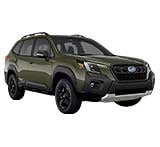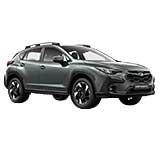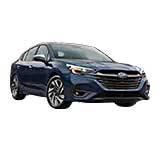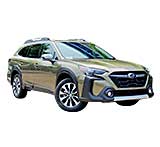2024 Subaru Forester Pros vs Cons, & How it Stacks Up to Competitors
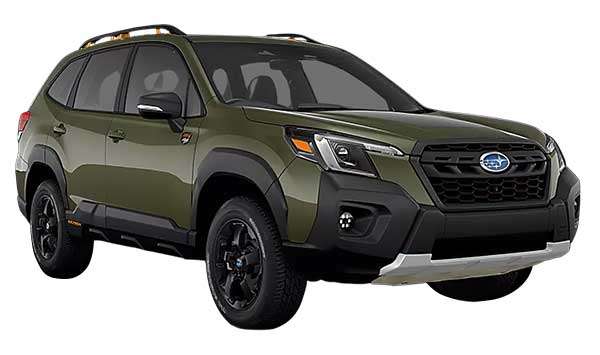
With over two decades in automotive experience, Norman Ruckpaul leverages his extensive background to help readers at Car Buying Strategies. His career in dealer management includes test driving and appraising hundreds of vehicles at the dealership level. At Car Buying Strategies, Norman uses his deep expertise of vehicle performance and shopping tactics to guide readers in selecting optimal cars and securing the best deals, while maintaining a customer-first philosophy.
When it comes to cars, James Murdock has the real-world experience to back it up. With an economics degree and over 20 years running the family dealership, he's managed it all - from sales to service and marketing. His role is to provide his expert opinion on vehicle performance and value. He meticulously fact checks all features and data with vehicle manufacturers to ensure the upmost accuracy.
Picture tackling mountain trails or snowy roads with confidence. If you're an adventurous family, or outdoor lover wanting a spacious, safe SUV for weekends escape or daily driving, the 2024 Subaru Forester demands your attention. This compact SUV contender rises above with ample room, standard all-wheel drive, and comprehensive EyeSight driver-assistance suite. But how does it stack against big players like the CR-V and CX-5? Let's explore the Forester’s pros and cons versus rivals to see if it’s the right adventure-ready SUV for you and your family.
What We Like: 14 Key Pros to Consider
The Forester brings some compelling strengths to the table for compact crossover shoppers. Here are some of its most appealing attributes:
1. Roomy and Comfortable Passenger Space
With generous front and rear headroom, legroom and hip room, the Forester delivers space for five adults to ride comfortably. The Forester excels at front and rear passenger room compared to the Mazda CX-5, Honda CR-V, Kia Sportage, and Volkswagen Tiguan. Key measurements include:
-
It offers best-in-class front headroom with 42.3 inches. The CR-V trails slightly with 41.3 inches up front.
-
Rear legroom is generous at 39.4 inches. The CX-5 has noticeably less rear leg stretch with only 39.0 inches.
-
With 57.2 inches of hip room, the Forester can fit 3 adults comfortably in the back. The Tiguan has 55.9 inches of rear hip room.
-
Six foot tall passengers can sit in the back without knees brushing the seats. Shorter competitors like the CX-5 have tighter rear legroom.
-
For car seats and boosters, the Forester’s rear space and flat floor provide plenty of fitment room. Accessing latch anchors is easy as well.
-
Panoramic power moonroof models open up the cabin nicely. The CX-5’s optional sunroof provides less overhead light.
The Forester’s blend of stretch-out passenger room in both rows tops these rivals, giving it an advantage for shoppers needing generous interior space.
Other Features that add to comfort include:
-
Comfortable Seating: Forester seats provide ample cushioning and support. Higher trims add power adjustable driver's seat, passenger seat and heated front seats for extra pampering. Heated steering wheel and heated rear seats are standard on the Luxury trim.
-
Automatic Climate Control: Dual-zone automatic climate control allows driver and passenger to dial in their preferred temperature.
-
Noise Insulation: The Forester cabin uses sound-deadening materials to minimize road and wind noise, creating a quieter, more relaxed environment inside.
2. Excellent Outward Visibility
Thin roof pillars and an upright greenhouse give the Forester best-in-class outward visibility. Large windows all around make it easy to place the Forester on the road and monitor surroundings.
Specific design elements enhancing visibility:
-
Narrow A-pillars avoid front corner blind spots
-
Tall seating position provides an elevated view of the road
-
Short front and rear overhangs make placing the Forester easier
Blind spot monitoring on higher trims provides an extra set of eyes monitoring the sides and rear.
3. Plush and Comfortable Ride Quality
The Forester soaks up bumps and ruts effectively thanks to suspension tuning that smoothly glides over most road imperfections. Specifics include:
-
MacPherson strut front and double wishbone rear suspension
-
Active torque vectoring enhances handling and stability
-
Aerodynamic design helps reduce wind noise
Wind and road noise is also hushed, making for relaxed highway cruising. Long road trips are no issue in the Forester. Compared to its rivals, the Forester stands out with:
-
Sound insulation and acoustic glass provide a quiet interior. The CX-5 suffers from more road noise on coarse pavement.
-
Wind noise is also minimized, making highway driving hushed. The boxy Tiguan generates more wind roar at speed.
-
Long trips are enjoyable thanks to the supple suspension and low NVH levels. The CR-V's ride gets choppy and loud on uneven roads.
The Forester combines ride comfort, interior quietness, and passenger pampering better than these key compact SUV competitors.
4. Nimble Handling Despite Size
for a compact crossover SUV, the Forester drives smaller than its exterior footprint suggests thanks to direct steering and a responsive chassis. Details enhancing maneuverability include:
-
Quick 14:1 steering ratio sharpens turn-in
-
Short 101.5 inch wheelbase enhances agility
-
Active torque vectoring improves cornering grip
Body lean is minimal around corners and the Forester reacts quickly to steering inputs. Short overhangs enhance maneuverability as well.
5. Standard Advanced Safety Tech
Subaru equips every Forester with Subaru's EyeSight suite and driver assists including:
-
EyeSight Driver Assist Suite (standard): Includes automatic emergency braking and pre-collision throttle management to avoid frontal crashes. Lane departure and sway warning keeps you centered. Advanced adaptive cruise control maintains set speed and distance. Lane centering with automatic emergency steering provides semi-autonomous driving.
-
High Beam Assist (standard): Auto high beam activation for better night vision when appropriate.
-
Brake Assist and Brake Override System (standard): Reduces engine power if both brake and gas pedals are pressed.
-
Blind Spot Detection (upper trims): Alerts you to vehicles in hard-to-see blind spots.
-
Rear Cross Traffic Alert (upper trims): Warns of approaching perpendicular traffic when reversing. It also comes with reverse automatic braking.
-
180 Degree Front View Monitor (upper trims): Gives view of front blind spots on display screen when pulling forward.
-
DriverFocus (Touring): Uses facial recognition to monitor driver attention and alert if distracted.
Overall, the Forester sets itself apart by making sophisticated active safety features standard across the model lineup.
Here is a comparison of the standard safety tech versus rivals:
-
The base CX-5 lacks standard active safety beyond a backup camera.
-
The CR-V has collision and road departure mitigation standard like the Forester but lacks advanced adaptive cruise control and lane centering capability.
-
The Sportage matches the Forester with forward collision warning and AEB but no lane centering.
Overall, the Forester sets itself apart by democratizing cutting-edge active safety features as standard equipment on every trim.
The Forester received a Five Star safety rating from the National Highway Traffic Safety Administration. (Reference: NHTSA). It also won the coveted TOP SAFETY PICK+ award from the Insurance Institute for Highway Safety. (Reference: IIHS)
6. Symmetrical AWD Comes Standard
Subaru’s proven symmetrical all-wheel drive system gives the Forester excellent wet or snowy weather traction. Power routes smoothly from front to rear, enhancing stability when accelerating or cornering.
Details of the AWD system:
-
Active torque split monitors and adjusts continuously
-
Variable gear ratio steering adds steering precision
-
X-MODE improves low speed traction in snow or mud
7. Smart, Flexible Cargo Space
With rear outboard seats folded flat, the Forester provides up to 71 cubic feet of cargo volume. The square tailgate opening makes fitting bulky objects easy. Thoughtful cargo touches include:
-
Underfloor storage bins keep gear secure
-
Integrated crossbars allow roof attachments
-
Cargo tie-down rings and rear gate hooks
Subaru Forester's cargo space versus key rivals:
-
The Forester provides up to 71 cubic feet of cargo space with the seats folded, topping the CX-5's 59.6 cubic feet.
-
The CR-V comes close at 68.7 cubic feet but the Sportage and Tiguan fall further behind.
-
Behind the rear seats, the Forester offers 33 cubic feet versus just 23.8 cubes in the Tiguan.
-
The Forester's large opening and flat floor enable fitting bulky items. The CX-5's tapered rear restricts room.
The Forester surpasses these compact SUV rivals when it comes to cargo hauling utility and maximum flexibility.
8. User-Friendly Infotainment System
An 8-inch touchscreen with Apple CarPlay/Android Auto comes standard. Navigation and a larger 11.6-inch display are optional. Physical controls flank the screen for easy operation.
Infotainment capabilities and connected services include:
-
Bluetooth hands-free calling and audio streaming
-
SiriusXM satellite radio
-
WiFi hotspot to connect multiple devices
-
STARLINK cloud apps for safety and convenience
Menus are logically laid out as well. Voice commands offer an alternative to touch control.
9. Light Off-Road Capability
The Forester isn’t a rock crawler but does provide some off-road assurance. Standard X-MODE optimizes the AWD system for conditions like mud or deep snow.
Further enhancements on the Forester Wilderness model:
-
Increased ground clearance to 9.2 inches
-
All-terrain tires with rugged tread pattern
-
Beefed up suspension components
-
Under guard skid plates
-
Hill descent control
10. Proven Reliability and Durability
Subaru’s track record of building lasting vehicles carries on with the Forester. High-strength steel construction gives it solidity. The Boxer engine design has inherent balance as well.
For peace of mind, Forester warranties include:
-
3 year / 36,000 mile bumper-to-bumper
-
5 year / 60,000 mile powertrain
-
10 year / 100,000 mile extended engine warranty
Owners routinely get 200k+ miles from their Foresters.
11. Confidence-Inspiring Braking Performance
Large 4-wheel disc brakes bring the Forester to smooth, short stops. Key technical braking features:
-
4-channel, 4-sensor ABS prevents wheel lockup
-
Brake assist boosts stopping power in emergencies
-
Electronic brakeforce distribution balances front/rear brake force
These enhancements provide braking performance matching or exceeding competitors.
12. Good Fuel Economy
Thanks to its efficient 4-cylinder engine, CVT transmission tuning, and low aerodynamic drag, the Forester achieves up to 33 mpg on the highway. Few competing AWD SUVs match this efficiency.
EPA estimated fuel economy:
-
City: 25 mpg
-
Highway: 33 mpg
-
Combined: 28 mpg
Comparing apples to apples - AWD competitors, the forester holds its own. The Sportage's 2.5-leter AWD has a combined MPG of 25, and the FWD ties the forester with 28 mpg combined. The CX-5 has 25 mpg combined with its 4WD and the Tiguan has 24 to 27 combined mpg - including its FWD models - all lower than the forester.
The Forester stands out for delivering efficiency on par with front-drive competitors, while retaining symmetric AWD traction. This gives it an advantage over AWD rivals.
(Reference: EPA)
13. Lower Priced with Many Trim Levels Choices
Here is a brief overview of what each 2024 Subaru Forester trim level offers:
-
Base Forester - $28,440: 17-inch wheels, roof rails, 6.5” display, cloth seats, manual driver’s seat, single-zone climate control
-
Premium - $31,390: the premium trim has alloy wheels, fog lights, All-Weather package, 8” display, leather-wrapped steering wheel
-
Sport - $32,960: Black exterior accents, unique wheels, LED DRLs, Sport cloth upholstery, paddle shifters
-
Limited - $35,075: Leather upholstery, heated front seats, larger touchscreen, Harman Kardon audio, power liftgate
-
Wilderness - $36,015: Raised suspension, all-terrain tires, skid plates, exterior cladding, water resistant upholstery
-
Touring - $38,490: Nappa leather seats, ventilated front seats, navigation, front view monitor, automatic high beams
The higher you go in the lineup, the more premium features are added. But even the base model comes well-equipped with the latest safety, technology, and capability.
With a starting price that is lower than many competitors, and a upper price that is lower or close to many rivals, the Forester is reasonably priced in its segment. With six trim levels and one powertrain to chose from, you should be able to fine a Subaru Forester model to suit your needs - and at a competitive price to its rivals.
Here are the price ranges of some close competitors:
-
Subaru Forester - $28,440 to $38,490
-
Mazda CX-5 - $30,675 to $41,975
-
Honda CR-V - $30,850 to $36,010 for non hybrid models
-
Kia Sportage - $28,565 to $39,365
-
Volkswagen Tiguan - $30,305 to $40,305
14. Good Resale Value
The Forester offers very good value. Kelley Blue Book named the Subaru Forester as both the lowest 5-Year Cost to Own and the Best Resale Value in its class. (Reference: KBB Cost to Own, Resale Value)
J.D. Power backs this up. They rated Resale value at 86/100 - one of the top in its class. It was ranked #2 overall for its class. (Reference: J.D. Power)
What We Question: 7 Cons to Consider
For all its strengths, the Forester isn’t perfect. Here are some of the most common complaints:
1. Only One Engine and Transmission Choice
The Forester offers just one engine/transmission choice: a 2.5-liter naturally aspirated 4-cylinder and continuously variable transmission (CVT). Those wanting more power or hybrid options will need to look elsewhere. The tradeoff is proven reliability for the single powertrain.
2. Pokey Acceleration
While fine for most driving, flooring the throttle results in only modest acceleration. Competitors like the CX-5 are considerably quicker. The continuously variable automatic transmission contributes to a laggy pedal response at lower speeds. According to Consumer reports, it takes 9.2 seconds to go from 0-60 mph. Fine for everyday driving but not a race car. (Reference: Car and Driver Road Test)
3. Coarse Engine Noise Under Acceleration
The flat-four boxer engine makes a thrummy growl under heavy throttle that some may find unpleasant. Open it up, and the CVT allows the engine to rev freely, exacerbating the noises. Light acceleration is quieter.
(Reference Source: Consumer Reports Road Test)
4. Drab Interior Styling
Function takes priority over form inside. Matte black plastics and basic textures make the Forester cabin look more economy car than near-luxury SUV.
Some examples:
-
Plain dashboard design with few flowing lines
-
Extensive use of hard plastics on doors and console
-
Base cloth seats look and feel inexpensive
Dashboard and door panels lack design flair.
5. Small Base Infotainment Screen
The standard 6.5-inch infotainment touchscreen looks tiny in the expansive dash panel. Stepping up to the larger 8-inch or 11.6-inch displays is worthwhile, but only available on pricier variants.
6. Light Duty Tow Rating
Need to tow heavier items like boats or RVs? The Forester’s 1,500 pound tow rating trails most competitors. Only the Wilderness model tows up to 3,000 pounds. Big towing needs may require looking at options like the CR-V.
7. Large Rear Headrests Impede Rear Visibility
Thick rear headrests block a portion of the rearview, creating a partial blind spot. Adding rear cross traffic alert helps compensate when reversing. Overall visibility remains excellent, however.
How the Forester Compares to Rivals
So how does the 2024 Forester stack up against its main compact SUV competitors? Here’s a look at how it fares.
Vs. The Mazda CX-5
Forester Advantages:
-
More rear legroom, cargo space, quieter ride, standard safety tech
CX-5 Advantages:
-
More powerful engine, nicer interior, lower cost tech, sportier handling
The Forester prioritizes space, quietness, and safety tech, while the CX-5 offers a more premium experience and driving verve. Choose based on priorities.
Vs. The Honda CR-V
Forester Advantages:
-
Standard AWD traction, more cargo space
CR-V Advantages:
-
Sleek styling, nicer interior, faster engine, better mpg
The Forester wins for AWD traction and cargo versatility. But the CR-V counters with more refinement, efficiency, and powertrain options. Another close one.
Vs. The Kia Sportage
Forester Advantages:
-
More headroom, legroom, better value and safety tech
Sportage Advantages:
-
Hybrid options, flashy styling, larger touchscreen, lower price
The Forester provides better passenger space, safety tech and value. But the Sportage counters with dramatic styling, hybrid options and a lower price.
Vs. The Volkswagen Tiguan
Forester Advantages:
-
More cargo room, better ride, proven safety tech, lower costs
Tiguan Advantages:
-
Luxury interior, more powerful engines, optional 3rd row
The Forester excels at space, ride comfort and safety aids. But the Tiguan offers a luxury feel cabin, more powertrains, and available 3rd row seating.
The Verdict
We think the 2024 Forester stands apart as a practical, safety-focused compact SUV with its roomy interior, standard AWD, and driver assists. For those needing an affordable, adventure-ready crossover to haul gear and family, the Forester delivers.
Competitors like the CX-5, CR-V, Sportage and Tiguan surpass it in some areas but none match the Forester’s blend of space, traction, and tech for the price.
If you prioritize utility for hauling over luxury, the 2024 Forester deserves consideration. It brings Subaru’s reputation for safety, reliability, and competence to this segment. For the right buyer, the Forester is ready for adventure.
Note: This article is based on our research and expert reviews. We are not affiliated with Subaru or any other automaker and do not receive any compensation for our reviews. This information is based on our opinions and the opinions of the expert reviewers we have referenced.

